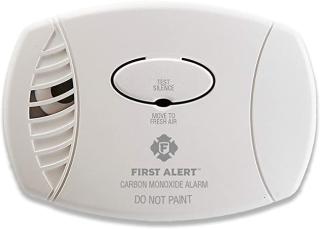Carbon Monoxide Safety

January 1st, 2007 Carbon Monoxide detectors became mandatory for all homes in Illinois
What is carbon monoxide?
Carbon monoxide (CO) is an odorless, colorless, deadly gas. Because one cannot smell, see, or taste it, carbon monoxide can kill you before you know it is there.
Where does carbon monoxide occur?
Carbon monoxide is a byproduct of a fuel burning process. Carbon monoxide can be emitted by gas or oil furnaces, clothes dryers, water heaters, wood stoves, fireplaces, gas ranges, space heaters. Improper venting or a clogged chimney can also cause problems. Fall and winter months also see many residents warming their cars prior to driving. Often times this is done in the garage or immediately outside the garage with the garage door open. Both these are dangerous practices and can put dangerous even lethal amounts of carbon monoxide inside a home in a matter of minutes.
Who is at risk?
Everyone! CO effects individuals differently depending on their size and medical history. There, families with young children or members with medical conditions should take extra precautions in the event that CO is detected.
Where do I place my carbon monoxide detector and what kind do I look for?
Carbon monoxide detector placement is the most important aspect of using a carbon monoxide detector for home safety. You can either install a single carbon monoxide detector, ideal if you have a small house, or more than one detector, with each levelhaving a separate piece, ideal for large multi-storied house. If you are installing a single piece for the entire house, the ideal location to install it would be in the area where you sleep. This idea is backed by the Consumer Product Safety Commission (CPSC). This will ensure that you hear the alarm and wake up even if you are in a deep slumber. Having additional detectors, one at each level or each room, is always advantageous considering it provides extra protection to your house. The specific gravity of carbon monoxide is 0.9657, while that of air is 1, which means both are roughly of the same weight. But often, carbon monoxide is accompanied by warm air let out by the appliances such as heaters, hence it tends to rise with the warm air. Therefore, it is ideal to place carbon monoxide detectors at a considerable height in the house. Never install carbon monoxide detector very close to fuel burning appliances. These appliances emit a small amount of carbon monoxide when they are started. Having a detector right above or besides the appliance can trigger the alarm on the release of this small amount of carbon monoxide. Also remember that the detector shouldn’t be placed within a periphery of 15 feet of any cooking or heating appliances.
What are the acceptable levels?
Less than 10 PPM: Acceptable limit.
10 or more PPM: Potentially deadly level of CO. Leave the building immediately. Call 911
What do I do when my CO detector goes into alarm?
Call 911 or your local fire department.
Should I open my windows if my detector alarms?
No, if your detector alarms it is indicating an unsafe atmosphere and wasting time opening windows could be a deadly decision. Get out, call 911 and crews will respond with very sensitive equipment that can trace the source.
What are the symptoms of CO poisoning?
CO poisoning symptoms can mimic the flu. Headaches or feeling better when you leave your home are also possible symptoms.
I heard CO detectors have many false alarms?
When CO detectors were first introduced they were adequate but easily alarmed in constant low level areas. In fact in December of 1994, when detectors were still new, the Chicago Fire Department responded to 1,851 false carbon monoxide alarms in a 24 hour period. This was due to a thermal inversion where cold air was trapped under a layer of hot air not allowing pollutants like automobile exhaust, to escape into the atmosphere. After this happened makers of the new detectors took notice and worked to make even better detectors. Today’s detectors have very good systems and some even have digital displays which are very accurate.
How long are CO detectors good for?
The lifespan of carbon monoxide detectors varies from 3 years up to 10 years, depending on the brand and model, at which time sensors begin to lose their sensitivity to detect carbon monoxide. It is recommended that you refer to the owner’s manual or contact the manufacturer to determine the lifespan of your particular carbon monoxide detector. Once the detector has reached the end of its normal lifespan, it should be replaced immediately. It may save your life! When choosing a carbon monoxide detector, make sure you get one with a battery backup for protection during a power outage. It is also recommended that you get one with a digital readout which displays the concentration of carbon monoxide.
What detectors do we recommend?
Many independent agencies have tested and compiled lists of all different makes and models of carbon monoxide detectors. Check to find the best performers and make sure the testing agency is also a qualified, reputable, and non-biased facility.These lists can easily be found on the internet by doing a simple search.